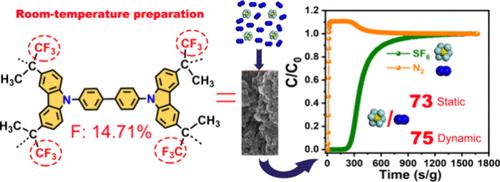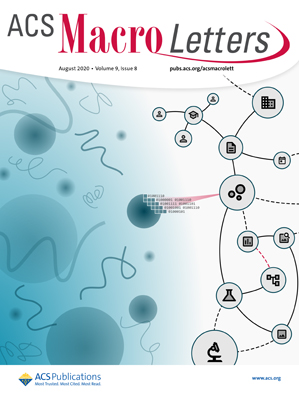用于高效吸附和分离 SF6 的氟官能化纳米多孔有机聚合物的室温合成
IF 5.2
Q1 POLYMER SCIENCE
引用次数: 0
摘要
六氟化硫(SF6)被广泛应用于电力行业,严重加剧了温室效应,因此有必要开发用于捕获 SF6 的高效材料,尤其是含氟材料。然而,现有的含氟材料通常需要复杂的单体和较高的合成温度。在此,我们报告了利用市售的 4,4′-双(9H-咔唑-9-基)-1,1′-联苯和 1,1,1-三氟丙酮在室温下合成氟功能化咔唑基纳米多孔有机聚合物(CNOP-7)的情况。CNOP-7 含有 14.7% 的氟原子,比表面积高达 1270 m2-g-1,具有出色的 SF6 吸附和分离性能。CNOP-7 的 SF6/N2 选择性在 273 K 时达到 107,在 298 K 时达到 73。此外,动态突破实验证实,CNOP-7 可从 SF6/N2 混合物中高效、反复地分离 SF6。分子模拟揭示了其高效分离背后的机理。这项研究为开发和制造高效封存 SF6 的吸附剂提供了新的视角。本文章由计算机程序翻译,如有差异,请以英文原文为准。

Room-Temperature Synthesis of a Fluorine-Functionalized Nanoporous Organic Polymer for Highly Efficient SF6 Adsorption and Separation
Sulfur hexafluoride (SF6) is widely used in the power industry and significantly contributes to the greenhouse effect, necessitating the development of efficient materials for SF6 capture, particularly fluorine-containing materials. However, existing fluorine-containing materials often require complex monomers and high synthesis temperatures. Herein, we report the synthesis of a fluorine-functionalized carbazole-based nanoporous organic polymer (CNOP-7) at room temperature, using commercially available 4,4′-bis(9H-carbazole-9-yl)-1,1′-biphenyl and 1,1,1-trifluoroacetone. CNOP-7 contains 14.7% fluorine atoms and exhibits a high specific surface area of 1270 m2·g–1, demonstrating excellent SF6 adsorption and separation performance. The SF6/N2 selectivity of CNOP-7 reaches 107 at 273 K and 73 at 298 K. Furthermore, dynamic breakthrough experiments confirm that CNOP-7 can efficiently and repeatedly separate SF6 from SF6/N2 mixtures. Molecular simulations reveal the mechanism behind its efficient separation. This work offers fresh perspectives on the development and fabrication of adsorbents for efficient SF6 sequestration.
求助全文
通过发布文献求助,成功后即可免费获取论文全文。
去求助
来源期刊
CiteScore
10.40
自引率
3.40%
发文量
209
审稿时长
1 months
期刊介绍:
ACS Macro Letters publishes research in all areas of contemporary soft matter science in which macromolecules play a key role, including nanotechnology, self-assembly, supramolecular chemistry, biomaterials, energy generation and storage, and renewable/sustainable materials. Submissions to ACS Macro Letters should justify clearly the rapid disclosure of the key elements of the study. The scope of the journal includes high-impact research of broad interest in all areas of polymer science and engineering, including cross-disciplinary research that interfaces with polymer science.
With the launch of ACS Macro Letters, all Communications that were formerly published in Macromolecules and Biomacromolecules will be published as Letters in ACS Macro Letters.

 求助内容:
求助内容: 应助结果提醒方式:
应助结果提醒方式:


